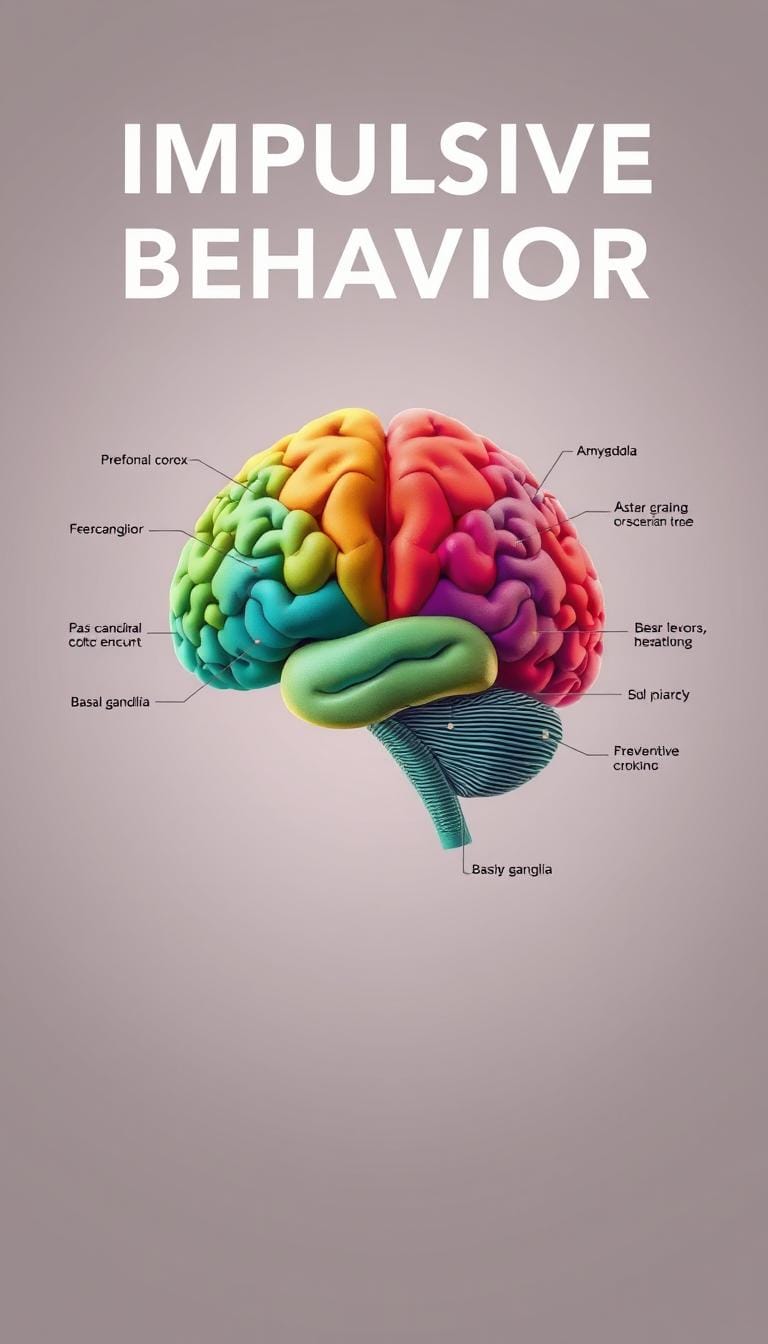Compulsive vs Impulsive: 5 Science-Backed Differences
Table of Contents
Ever wondered why some actions feel like habits while others seem sudden?

The difference between compulsive and impulsive behaviors isn’t always easy to see. As someone who’s studied brain science, I’ve seen how getting these terms mixed up can lead to misunderstandings.
Compulsive actions repeat over and over, like washing hands excessively. Impulsive choices, like grabbing a snack without thinking, happen quickly and can be hard to stop. Both types of behaviors shape how we act, but they have different causes and effects.
This article will explain the main differences between compulsive and impulsive behaviors. This way, you can recognize them in everyday life. Let’s explore the science behind why one feels unstoppable and the other unplanned.
Introduction to Compulsive vs Impulsive Behaviors
Knowing the difference between compulsive and impulsive actions is key to everyday life. Compulsive behavior, like checking locks over and over, is done to calm anxiety. On the other hand, impulsive actions, such as sudden shopping sprees, don’t follow a pattern. I became curious about these differences because they affect how we deal with stress and make choices.

Setting the Context
Compulsive behavior affects millions, but its causes are often not understood. Research shows it can be a sign of deeper mental health issues, not just bad habits. Unlike impulsive acts, compulsions keep happening even if they cause problems. This difference is important for getting help or changing our lives.
My Curiosity and Journey
My journey began when I noticed my hands washing for long periods. Was it just cleanliness, or something more? Learning about compulsive behavior showed me how it differs from impulsive decisions. My goal is to make these patterns clearer and help others understand their own triggers.
Understanding the Science Behind Behavior Patterns
Exploring impulsive behavior and compulsive actions led me to brain science. Studies reveal these patterns start in certain brain areas. The prefrontal cortex handles decisions, and the basal ganglia links to repetitive actions.
When these areas don’t talk well, behaviors become automatic or unplanned.

- Impulsive choices often involve quick reactions without thinking
- Compulsive acts repeat even when they cause harm
- Neurotransmitters like dopamine play key roles in both
A table comparing brain activity helps clarify differences:
| Behavior Type | Brain Region | Key Function |
|---|---|---|
| Impulsive | Anterior Cingulate Cortex | Makes quick decisions |
| Compulsive | Basal Ganglia | Drives repetitive habits |
My research showed impulsive behavior is about momentary urges. Compulsions feel like they must be acted on. This science explains why some habits are hard to control.
Breaking it down made complex ideas simpler. It’s like solving a puzzle where each brain part has its role.
Identifying Key Traits of Compulsive Behavior
Understanding what makes compulsive behaviors unique is important. It helps us see the difference between compulsive and impulsive actions. Let’s explore what makes compulsive tendencies stand out.
Defining Compulsive Tendencies
- Repetitive actions done to relieve anxiety or stress.
- Feel like a mental “have to” instead of a choice.
- Follow strict routines, like checking locks many times.
- Linked to anxiety disorders or obsessive-compulsive patterns.
Behavioral Markers and Traits
Key signs include:
- Time-consuming rituals that disrupt daily life.
- Little to no joy from the act itself.
- Stopping attempts cause intense distress.
- Often linked to deep emotional struggles.
Spotting these signs helps us understand the difference between compulsive and impulsive behaviors. My own experience showed how these patterns differ from impulsive, unplanned actions. Recognizing compulsive traits begins with noticing their emotional purpose—unlike impulsive reactions, which are often spontaneous.
Spotting Impulsive Behavior Traits in Daily Life
Spotting impulsive behavior starts with noticing small daily actions. Compulsive vs impulsive examples often involve making decisions quickly. For example, buying something on sale without thinking about it is a classic sign.
- Spontaneous trips: Planning a weekend getaway on a whim, even without travel plans.
- Emotional spending: Buying clothes after a bad day, not because of need.
- Interrupting others: Finishing someone’s sentences during conversations.
| Impulsive Example | Signs to Notice |
|---|---|
| Snapping at someone in traffic | Reacting aggressively before thinking |
| Changing plans last minute | Ignoring commitments for new ideas |
| Trying trends without research | Jumping into fad diets or workouts |
These moments show how impulsivity is different from compulsive habits. Unlike compulsive behaviors, like constantly checking emails, impulsive acts are immediate and lack a ritual. Notice choices that feel rushed or unplanned. Being aware is the first step to understanding the difference.
Why I Believe Differentiation is Crucial
Learning about compulsive vs impulsive personality traits changed my life. I used to mix them up, but now I see the difference clearly. This clarity has made a huge impact.
Personal Observations
First, I noticed my habits. Compulsive actions felt like loops, like constantly checking emails to calm down. Impulsive choices were quick, like buying something I didn’t need. Mixing them up didn’t help.
The Impact on Everyday Choices
Understanding the difference changed my daily life. Here’s how:
- Compulsive habits need long-term strategies, like mindfulness for anxiety-driven actions.
- Impulsive urges demand quick checks—pausing before acting reduces rash decisions.
When I figured out compulsive vs impulsive personality traits, my choices became more thoughtful. Small changes, like tracking triggers or setting 10-minute pauses before big purchases, made life simpler. This isn’t just theory—it’s practical for anyone wanting to master their habits.
Exploring compulsive vs impulsive: Scientific Insights
Looking into compulsive vs impulsive traits starts with brain studies. These studies show how these behaviors differ in brain wiring and daily life.
Research Findings and Data
- Research shows compulsive actions repeat even when outcomes are negative.
- Impulsive choices often arise from immediate rewards overriding long-term goals.
Neurological Underpinnings
| Aspect | Compulsive Traits | Impulsive Traits |
|---|---|---|
| Brain Region | Basal Ganglia (Striatum) | Pre-frontal Cortex |
| Function | Reinforces repetitive habits | Manages impulse control |
| Common Disorders | OCD, addiction | ADHD, substance use |
Implications for Mental Health
Understanding these traits helps tailor treatments. Misdiagnosing can lead to ineffective therapies. For example, addressing compulsions may need habit-breaking strategies, while impulsivity might focus on decision-making training.
My research shows personalized approaches improve outcomes. Small changes in therapy aligning with these traits can make a big difference.
Real-Life Examples of Behavioral Differences
Understanding the differences between compulsive vs impulsive decision making becomes easier with real-world scenarios. Let’s explore how these behaviors manifest in everyday situations.
At work, a colleague checks emails every 10 minutes to feel “productive.” This compulsive habit comes from anxiety about missing details. On the other hand, a coworker might blurt out opinions in meetings without pausing. This is a classic impulsive response driven by immediate urges.
Here’s how these patterns compare in daily life:
- Shopping: Compulsive behavior might involve buying identical items in bulk “just in case,” while impulsive decisions could mean buying a dress on a whim, despite needing funds elsewhere.
- Health Choices: A compulsive person might rigidly count calories every meal, while an impulsive eater might skip meals entirely and overeat later.
| Scenario | Compulsive Decision | Impulsive Decision | Outcome |
|---|---|---|---|
| Work Deadline | Rewriting reports endlessly to avoid mistakes | Skipping steps to finish early | Perfectionism vs. rushed results |
| Finances | Hoarding savings “just in case” | Spending a bonus immediately on a luxury | Stagnant growth vs. sudden debt |
These examples show how compulsive vs impulsive decision making uniquely shape outcomes. Recognizing these patterns helps address behaviors that disrupt daily life.
Analyzing Decision-Making in Compulsive and Impulsive Actions
Looking into compulsive vs impulsive psychology shows us how decisions are made. My studies found big differences in how people make choices. For example, compulsive actions come from strict mental patterns. On the other hand, impulsive actions happen quickly.
Case Studies from My Experience
Watching people over time showed me patterns. One person kept checking locks over and over (compulsive), because of worry. Another colleague bought things on a whim (impulsive), because of quick wants. These examples show how compulsive vs impulsive psychology affects our actions in different ways.
- Compulsive: Ritualistic checking of emails hourly
- Impulsive: Sudden decision to quit a job without planning
Cognitive Processes Involved
| Aspect | Compulsive Behavior | Impulsive Behavior |
|---|---|---|
| Decision Time | Delayed, repetitive | Immediate, spontaneous |
| Emotional Influence | Anxiety-driven | Excitement-driven |
| Neurological Basis | Hyperactive prefrontal cortex | Underactive prefrontal cortex |
These differences show how our brains work differently. Knowing this helps us understand why some choices feel like we must do them. Others feel like we can change our minds easily.
My Personal Journey Understanding These Behaviors
It wasn’t simple to tell compulsive from impulsive actions. At first, I got them mixed up. I thought routines were urges and impulsive choices were habits. Every mistake became a lesson.
Challenges I Faced
- Confusing symptoms: Distinguishing behaviors required constant research.
- Real-life misinterpretations: Mislabeling my own decisions as compulsive when they were impulsive.
- Finding reliable resources: Sifting through vague online articles to locate scientific studies.
Lessons Learned
- Self-awareness matters: Tracking daily choices helped spot patterns.
- Professional guidance: Therapists clarified neurological differences between urges and impulses.
- Action vs. habit: Compulsions often mask anxiety, while impulses respond to immediate rewards.
Learning about these behaviors changed how I see decisions. Now, I see compulsions as rigid cycles driven by anxiety. Impulses are quick reactions. Small victories, like pausing before acting, boosted my confidence. This journey showed me growth begins with curiosity—and asking for help when needed.
Conclusion
Understanding the difference between compulsive and impulsive behaviors is important. Science tells us they come from different brain processes. This affects our habits and mental health.
Compulsions are about following strict routines. Impulsivity is about acting on the spur of the moment. Knowing this helps us grow.
Self-awareness is key. It helps us see why we make certain choices. This can lead to better habits and mental health.
Take time to think about your habits and urges. Writing them down or talking to someone you trust can help. Small changes, like pausing before acting, can make a big difference.
This journey is about making progress, not being perfect. By learning more, you can make better choices. Keep exploring and remember, every new insight brings you closer to your goals.






